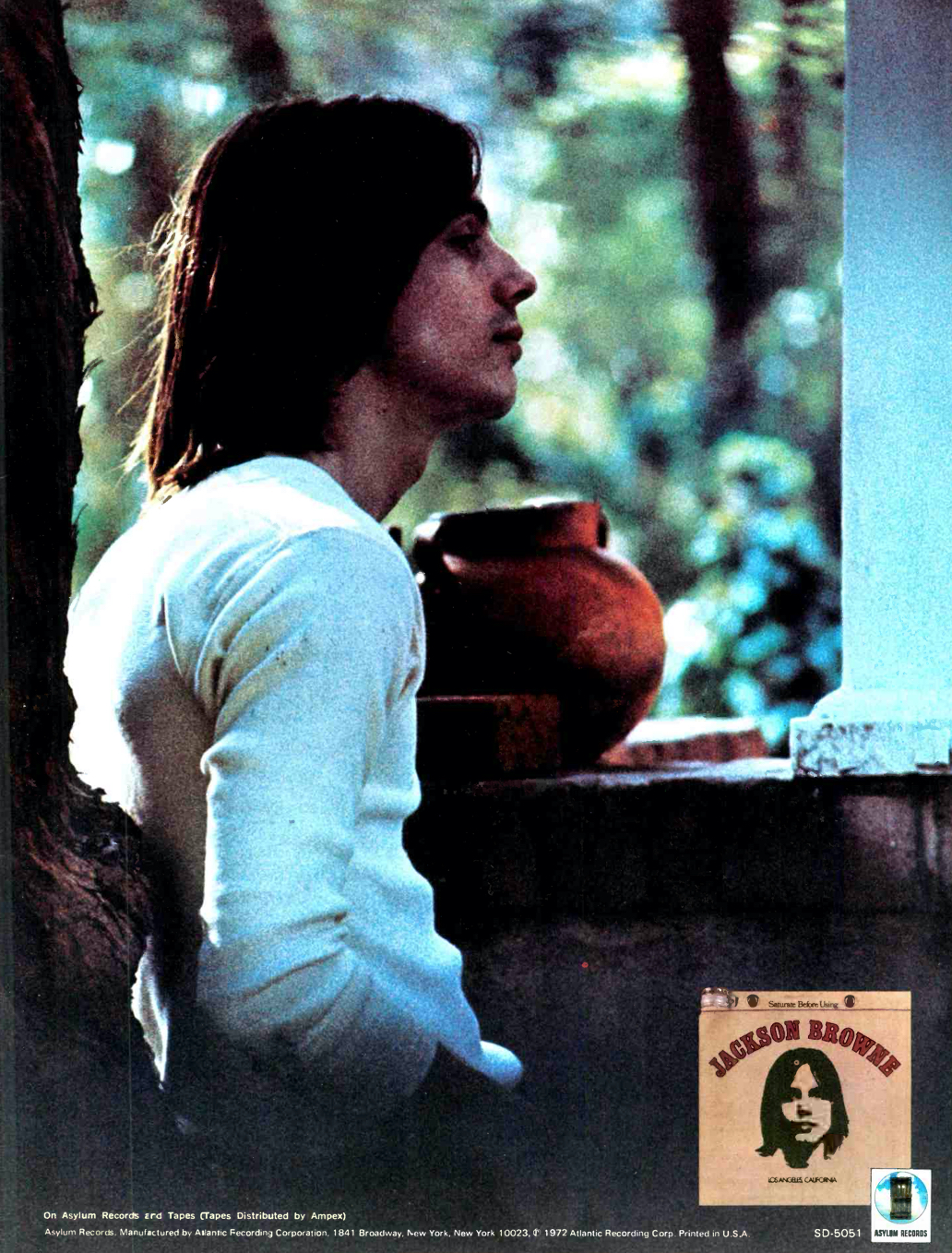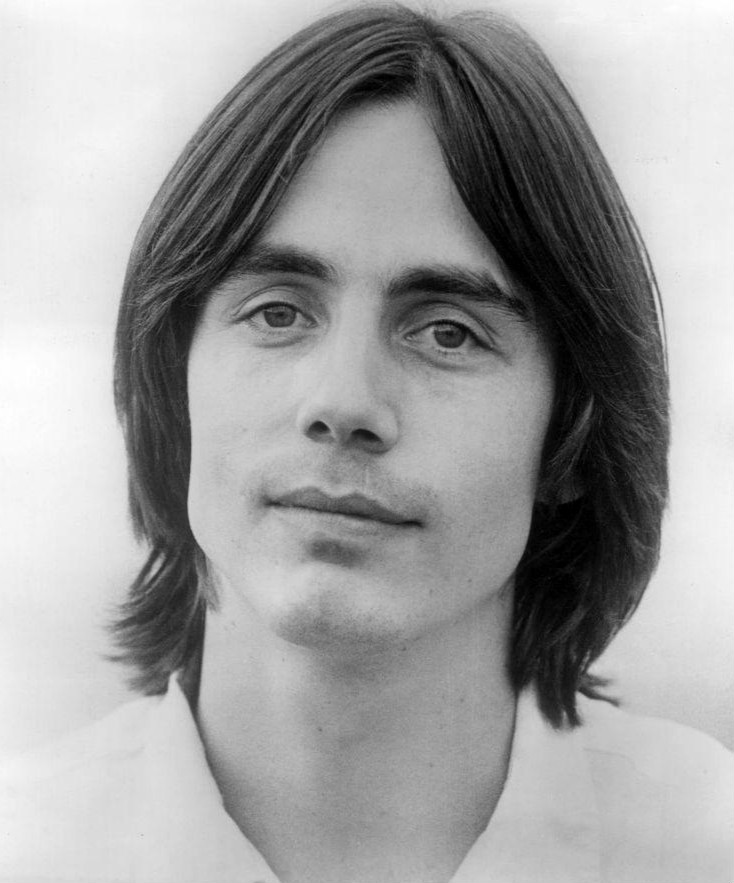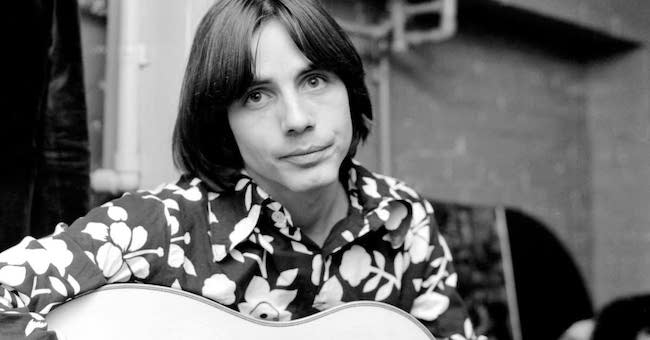
Released in late January 1972, Jackson Browne’s debut album established him as a quintessential L.A. singer-songwriter by year’s end. Two breezy single hits—one, his debut with “Doctor My Eyes,” the other “Take It Easy,” the Eagles’ first, anthemic seven-inch, written by Browne with a crucial lyric insertion from Glenn Frey—pinned Browne to Los Angeles’ musical map. Yet for all its sun-kissed Cali charm, Jackson Browne is the work of a precocious troubadour whose style was shaped as much by Greenwich Village as by his Southern California stomping grounds.
Sift through Browne’s early pilgrimage from California to the Big Apple, where he toiled as folk apprentice, and the songs on his first full-length suggest a direct line between the urban folk scene centered in New York City (and the Village in particular) and his home turf’s circuit of clubs in Los Angeles and Orange counties. Solo gigs in his mid-teens and brief band affiliations with the Nitty Gritty Dirt Band and Pamela Polland’s band, after graduating high school in 1966, were under his belt when he headed east for a gig as a staff writer with Nina Music, the music publishing arm of Elektra Records, the influential indie label.
It was there that Browne honed his songs under the aegis of the era’s preeminent folk music label, which had formalized the role of original material with 1965’s Singer Songwriter Project, showcasing the next wave of artists following in the footsteps of Bob Dylan, Tom Paxton, Phil Ochs and their peers. In New York, Browne mingled reportage on current artists and his own songwriting efforts with gigs backing Elektra artists Tim Buckley and Nico (neé Christa Päffgen), the Velvet Underground chanteuse with whom Browne was romantically involved for a time, and who would be among the first to cover his first evergreen, “These Days.”
That song, a wise-before-its-time self-assessment, along with other early works like “Shadow Dream Song” and “Holding,” found champions in the Nitty Gritty Dirt Band, Tom Rush, Nico, Steve Noonan, Joan Baez, Gregg Allman, Linda Ronstadt and the Byrds, all of whom covered Browne songs before his recording debut. Returning to California in 1968, Browne’s Elektra apprenticeship continued with an experiment in rustic woodshedding inspired by The Band’s Music From Big Pink, bringing Browne and several fellow tunesmiths to the Paxton Ranch, an isolated lodge in Gold Rush country where lack of adult supervision sabotaged creative output. Years later, Browne would wryly note that he might have finished his first album years earlier had he stayed in L.A.

However frustrated Jackson Browne may have been waiting to record, the delay proved propitious. Crucial to his eventual emergence was David Geffen, the ambitious manager who made Browne his new mission after parting ways with his first client, Laura Nyro. When Geffen lobbied Atlantic Records’ chairman Ahmet Ertegun on signing Browne, Ertegun instead challenged him to build his own label, offering to back the venture. Browne became the first artist signed to Asylum Records, anchoring a boutique roster dominated by Cali songwriters including Tom Waits, Judee Sill, Ned Doheny and transplants John David Souther and David Blue, himself an Elektra alumnus.
Browne entered Crystal Sound Studios in 1971 in the wake of James Taylor’s breakthrough with Sweet Baby James, which heralded the ascendance of acoustic singer-songwriters and cleared a path to the charts. The Taylor album also provided Browne with crucial studio allies in the rhythm section of bassist Leland Sklar and drummer Russ Kunkel, who, together with keyboard player Craig Doerge, would soon become known as “The Section” for their supple, intuitive support. That collaboration paid dividends on “Doctor My Eyes,” Browne’s deceptively sunny, uptempo meditation on lost innocence. Driven by Browne’s insistent piano, Sklar’s galloping bass line and Kunkel’s drums and conga, the track cushioned Browne’s lead vocal with signature harmonies from David Crosby and an uncredited Graham Nash. Its infectious energy belies the lyrics’ dark parable of lost innocence, asking whether the cost of experience “is having learned how not to cry,” touching on a frequent Browne theme in the tension between idealism and maturity. However downbeat its message, the single cracked into the Top 10, peaking at #8.
Tucked inside a propulsive arrangement punctuated by Jesse Ed Davis’ taut lead and rhythm guitar, that moment of self-doubt reveals Browne’s inward perspective and a melancholy that periodically rises from his ballads. The album’s 10 songs lean on identity, community and mortality as focal points, with ballads dominant even if Browne and the label deployed uptempo songs as singles.
“Rock Me on the Water” followed as Browne’s second single, another piano-based piece reinforced with a fuller band arrangement and electric firepower. Two other themes focal to Browne’s writing from that period shape its lyrics—premonitions of approaching apocalypse, and a longing for community—and animate a secular anthem built on gospel chords and decorated with water imagery, a frequent Browne poetic trope:
“Oh people, look around you
The signs are everywhere
You’ve left it for somebody other than you
To be the one to care…”
Part spiritual wakeup call, part environmental warning, the song had appeared in Browne’s live sets as early as 1970, and was already covered by Johnny Rivers, Brewer and Shipley, and Linda Ronstadt before Browne’s version was released. While the single version fell short of the Top 40, stalling at #28, “Rock Me on the Water” was only the first in a series of Browne originals extolling calls to social action, an aspiration Browne would fulfill throughout his career with frequent benefit performances in support of social and political causes.
Where the two singles courted a more mainstream audience with pop-rock polish, Jackson Browne casts a deeper spell in the album’s more pensive moments. “Jamaica Say You Will” was another Browne already had in circulation as a cover, a romantic interlude whose seafaring protagonist might have stepped out of an older folk valentine, water imagery again a common denominator.
“From Silver Lake” offers another glimpse of Browne seeking fellowship that references the then-working- and middle-class neighborhoods east of Hollywood where Browne and other cash-strapped musicians lived and played in their scuffling days. “Something Fine” mines the same mellow intimacy, savoring friendship as a welcome buzz, a metaphor in which “Morocco” translates as hashish.
Related: Photographer Henry Diltz on the early ’70s LA music scene
Of all the ballads on his debut, “Song for Adam” is at once the quietest and most powerful, an elegy for Adam Saylor, one of the friends who had accompanied Browne on his pilgrimage to Greenwich Village five years earlier. Finger-picked guitar and a dolorous viola descant support Browne’s quiet vocal as he recalls Adam as “a friend of mine” though “I did not know him well,” a young man “alone into his distance.”
“I could guess what he was laughing at, but I couldn’t really tell,” Browne continues. “Now the story’s told that Adam jumped, but I’m thinking that he fell.” His allusion to his title subject’s suspected suicide becomes a meditation on mortality, a topic that recurs in “Looking Into You” and will reappear in subsequent Browne albums, from his eventual version of “These Days” on his sophomore album and as a main theme of his third and finest long-player, 1974’s Late for the Sky, and on its successor, The Pretender.
The late ’70s would see Browne leaning into rock firepower, his topical focus shifting toward more conventional romantic and generational tropes, before returning to the social and philosophical poles that informed his earliest work. His debut was re-released in September 2023 on vinyl and CD in its original packaging with newly remastered audio. The 180-gram vinyl and CD packages have the texture of the original (burlap water bag) along with the water sleeve vinyl cover, and includes a lyric sheet insert.
BONUS VIDEO: Watch Jackson Browne perform an intimate solo version of “Something Fine”
Related: Our Album Rewind of Browne’s Running on Empty
- Los Lobos’ ‘Kiko’: A Hallucinatory Masterpiece - 05/26/2024
- Neil Young & Crazy Horse’s Debut: Of Rivers and Cowgirls - 05/14/2024
- Steely Dan ‘The Royal Scam’: Rock on a Grand Scale - 05/10/2024


13 Comments
About Jackson Browne..I saw him when I was in my twenties in small venue in St. Louis . As he entered the stage I was overcome by his larger than life presence. Having a third row isle seat I jumped up and yelled out RUNNING ON EMPTY. To this day I will never forget that would be his second song , and he came right to the edge of the stage and looked right at me and sang right to me. I am 60 now, thanks Jackson for the wonderful memory that keeps me going,.
Wow! It sounds awesome! Insane him much later and was struck by him from quite a distance! His songs speak volumes! We are happy to have seen his great artistry and musicianship!
Browne has this ability to draw you in with quiet songs that lead to wonderful endings. I too have seen him perform a number of times. Most memorable was the Beacon theater nyc. He played pretty much everything and then some. It will be an interesting evening
to have Browne and James Taylor sharing their talents in 2021. If it ever happens!
One of the true musical geniuses that can do it all. I’ve seen Jackson 9 times over 45 years.
When entering the venue of my first Jackson concert, I was overwhelmed the the shear power of his vocals that embodied the entire room…
My Husband & I have seen Jackson Browne perform many times through the years & actually had the opportunity to meet him a few times. As always they were great shows that we wished never ended. He is truly a great Human being who is as humble as one could imagine.
JBs first four albums are classics and a must for any music collection
No mention of the first album’s name? So it wasn’t really titled “Saturate Before Using”?
It’s in the opening paragraph… Jackson Browne… self-titled.
No the album was supposed to be a self titled album but the burlap sack used for the album cover had saturate before using printed on it and the rest is history
Almost everyone in the world gets it wrong. “Saturate” because it is a waterbag. “Jackson Browne” is the artist. “Los Angeles Ca” is the title.
Totally agree with Rick Reed – Jackson Browne’s first four (I would even go to five) albums were
Insightful and creative works of a true artist.
I got turned onto Jackson Browne’s talent in 1972, at a small, independent local record shop, as a sophomore in high school.
Fast forward to 1976, as a sophomore in college.
Not a fan of Mr. Browne’s public politics of the late 70s and onward, but man, I couldn’t begin to count the number of times I spun “The Pretender”, as well as all Jackson Browne’s preceding albums, on our campus FM station, as a college D.J., as well during my personal down-time.
Then, to follow-up with “Running On Empty”, Browne proved he had a creative streak, and cerebral lyrics that was unstoppable for almost a decade.
Great article and a great era for music.
i always thot “saturate before using” was a hint to get stoned before listening… so i did…